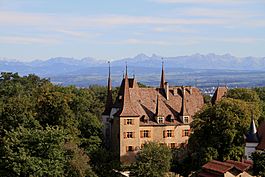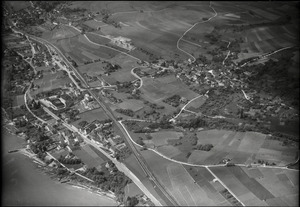Gorgier facts for kids
Quick facts for kids
Gorgier
|
||
|---|---|---|

Gorgier Castle above the village
|
||
|
||
| Country | Switzerland | |
| Canton | Neuchâtel | |
| District | Boudry | |
| Area | ||
| • Total | 13.97 km2 (5.39 sq mi) | |
| Elevation | 491 m (1,611 ft) | |
| Population
(December 2007)
|
||
| • Total | 1,851 | |
| • Density | 132.50/km2 (343.17/sq mi) | |
| Postal code |
2023
|
|
| Surrounded by | Autavaux (FR), Bevaix, Boudry, Estavayer-le-Lac (FR), Forel (FR), Montalchez, Noiraigue, Provence (VD), Saint-Aubin-Sauges, Travers | |
Gorgier was once a municipality in the canton of Neuchâtel, Switzerland. It was located in the Boudry district. On January 1, 2018, Gorgier joined with several other towns like Bevaix, Saint-Aubin-Sauges, Vaumarcus, Montalchez, and Fresens to form a new, larger municipality called La Grande-Béroche.
Contents
A Look at Gorgier's Past
Gorgier is an old place! It was first mentioned in official records way back in 1252. Back then, it was known as de Corgie.
Exploring Gorgier's Geography
Gorgier covers an area of about 14 square kilometers (about 5.4 square miles). A big part of this land, about 33.3%, is used for farming. Even more, about 56.2%, is covered by forests. The rest of the land, around 8.3%, has buildings or roads, and a small part (2.2%) is unproductive, meaning it's not used for anything.
The town of Gorgier is built on a hill. It sits right above Lake Neuchatel, which is a beautiful lake. Besides the main village of Gorgier, there are also smaller areas called hamlets, like Chez-le-Bart, and some farmhouses known as Les Prises, located right by Lake Neuchatel.
Gorgier's Coat of Arms
Every town has a special symbol called a coat of arms. Gorgier's coat of arms is described as Per pale Gules and Argent, a Rose counterchanged. This means it's split down the middle. One side is red (Gules) and the other is silver (Argent). In the middle, there's a rose that changes color from red to silver on each side.
Who Lives in Gorgier?
As of 2008, about 15% of the people living in Gorgier were from other countries. Over ten years (from 2000 to 2010), the number of people living in Gorgier grew by about 10.8%. Most of this growth was because people moved there.
Most people in Gorgier speak French as their main language (about 86.2%). German is the second most common language, and Italian is the third.
In 2008, the population was almost evenly split between males and females. About 21.9% of the people living in Gorgier in 2000 were actually born there. Many others were born in the same canton (state) or elsewhere in Switzerland. About 19.1% were born outside Switzerland.
When it comes to age, in 2000, about 23.1% of the population were children and teenagers (under 20 years old). Adults (20-64 years old) made up 59.3%, and seniors (over 64 years old) were 17.6%.
The chart below shows how Gorgier's population has changed over many years:

Important Historical Sites
Gorgier is home to some very important historical places. These are so special that they are listed as heritage sites of national significance in Switzerland.
- The amazing Castle
- A Gallo-Roman settlement at La Béroche, which means it was a place where Romans and Gauls lived together long ago.
- A prehistoric lake shore settlement, which is a very old village built by a lake.
A UNESCO World Heritage Site
One of the most exciting sites in Gorgier is the Les Argilliez prehistoric pile-dwelling settlement. This site is part of the Prehistoric Pile dwellings around the Alps which is a UNESCO World Heritage Site. This means it's recognized as super important to the whole world!
The Les Argilliez site actually has two ancient villages. One village, from the Classical Cortaillod culture, has remains of six wooden piles (like stilts) from around 3841 to 3817 BC. The other village, from the Late Cortaillod period, has two piles from 3531 to 3528 BC. These villages are found underwater in a small bay. You can still see the remains of these ancient homes! Things like stone axes, antler handles, and pottery pieces have been found there.
How People Make a Living in Gorgier
In 2010, the unemployment rate in Gorgier was 4.5%. This means a small number of people who wanted jobs didn't have one.
People in Gorgier work in different types of jobs:
- Primary Sector: This includes jobs that get raw materials from nature. In 2008, about 61 people worked in farming, forestry, or fishing.
- Secondary Sector: These jobs involve making things. About 91 people worked in manufacturing (making goods) or construction (building things).
- Tertiary Sector: These are service jobs. About 275 people worked in areas like sales, transportation, hotels, restaurants, education, or healthcare.
Many people who live in Gorgier travel to other towns for work. In 2000, about 631 people left Gorgier to work elsewhere, while 280 people came into Gorgier for their jobs. Most people (65.9%) used a private car to get to work, while 10.3% used public transportation.
Religion in Gorgier
According to a 2000 survey, many people in Gorgier belonged to different Christian churches. About 25.5% were Roman Catholic, and 46.3% belonged to the Swiss Reformed Church. There were also smaller numbers of people who were Orthodox Christian, Christian Catholic, or belonged to other Christian churches.
A small number of people were Islamic (about 1.35%) or Jewish (about 0.11%). Some people were also Buddhist. About 16.73% of the population said they didn't belong to any church or were agnostic or atheist.
Learning and Education
Education is important in Gorgier. About 36.8% of the people have finished high school (called "upper secondary education" in Switzerland). Also, about 14.1% have gone on to get higher education, like from a university or a specialized college.
In the canton of Neuchâtel, where Gorgier is located, children usually go to two years of non-required kindergarten. After that, they have five years of required primary school. Then, they go to four years of required secondary school. Many students travel to bigger schools outside their home town for secondary education.
During the 2010-2011 school year, Gorgier had two kindergarten classes with 36 students. It also had five primary classes with 101 students.
In 2000, 458 students came to Gorgier from other towns to go to school, while 68 students from Gorgier went to schools outside the municipality.
See also
 In Spanish: Gorgier para niños
In Spanish: Gorgier para niños









